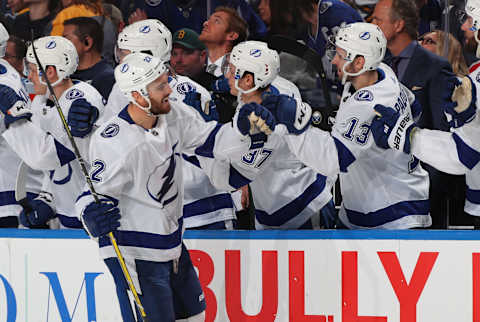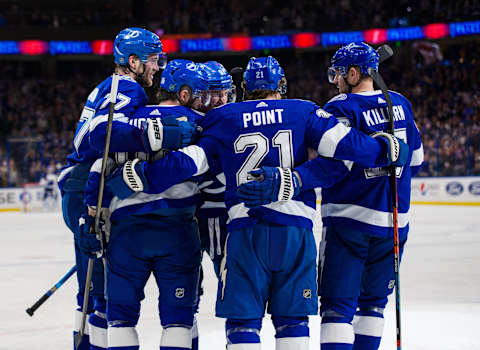Tampa Bay Lightning: Recent Success Shows The Bolts Are Back


The Tampa Bay Lightning have seemingly turned their season around as of late, as they have won 7-straight games. What have they done recently that has led to this success?
A few weeks ago, I did a deep dive into what was going wrong for the Tampa Bay Lightning this season. I looked at the number of injuries the Tampa Bay Lightning have dealt with compared to last season, specifically to their core players.
Secondly, I looked at their fast starts not being sustained for the full 60-minute games. I also looked untimely missed opportunities on the powerplay, as well as the powerplay’s importance to the teams’ success. Finally, I looked at the struggling netminder, Andrei Vasilevskiy.
To start, let’s look at the injuries over the last seven games, all of which they have won. Only two players missed time while the Lightning were going through their seven-game win streak – Tyler Johnson (19 points in 36 games) and Ryan McDonagh (11 points in 40 games). Johnson missed the first game, a 6-1 win over Florida, and McDonagh missed a chunk of the sixth game, a 5-3 win over Ottawa, and all of the last game, a 3-1 win over Carolina.
More from Puck Prose
- Detroit Red Wings 2023 Rookie Camp Has Plenty of Ups and Downs
- This Columbus Blue Jackets rookie doesn’t want to be forgotten
- 2 trades the Boston Bruins must make to secure the Stanley Cup
- 3 reasons the Avalanche won’t win the Stanley Cup in 2024
- This is a big year for Alex Turcotte and the Los Angeles Kings
However, those were the only two injuries that the Lightning had to deal with. They happened at the very start and then in the last two wins, meaning that for five straight games, they dealt with no injuries.
Immediately, the Tampa Bay Lightning were dealt a good hand of health and it has gone a long way. Moving forward, McDonagh is still injured and he has been one of the best Lightning defenders in his own end. If he’s out any longer, his presence, or lack thereof, could bite the Lightning. The good news is, it isn’t a serious injury, so he may not be out much longer.
With all that said, the Tampa Bay Lightning very clearly needs their star players healthy, as they have shown over this win streak. If they can keep a fairly clean bill of health, then maybe they can recapture last years’ greatness.

Fast Starts
Next up, how about those fast starts? In my last post, the Lightning had scored first in nine of their 12 home games and seven times in 15 away games, giving them a total of 16 of the first goals in 27 games. Over the last seven games, they’ve scored first in two of three home games and two of four away games (four of seven total).
But that’s not always the signs of a fast start. These stats, however, are. The Tampa Bay Lightning outscored teams 33 to 19 in the first period in the 24 games I previously looked at, while only outscoring opponents 67 to 64 in the second and third periods, combined. It was very clear then that they would dominate in the first 20 minutes and lose their steam in the next 40.
Over the last seven games, they’ve outscored teams 8 to 4 in the first, 12 to 9 in the second, and 9 to 2 in the third. Those last two periods, especially that third period, prove that they’ve learned to not only sustain their leads but to expand them and dominate. What’s even more daunting are these stats that I’m about to bring up.
In my first piece, the Lightning outscored opponents 2-0 when losing after the first, tied 13-13 when the game is tied after the first, and outscored 15-17 when entering the second period with a lead. As for the third, they outscored opponents 23-15 when entering with a lead, outscored 7-8 when entering the period tied, and outscored 7-11 when entering the period losing.
That shows a lack of desire to push for a lead when they don’t have one, and it needed to end. Over the last seven games, it has. When entering the second period with a lead, they’ve outscored opponents 3-1. When entering the second period tied, they were outscored 3-4. Finally, when entering the period while down, they’ve outscored opponents 6-4. But again, it was the third period that they improved the most in.
When entering the final period of play with a lead, they’ve tied opponents 2-2, taking a more conservative approach. When entering while tied, the Lightning have outscored opponents 1-0, as it has only happened once.
Finally, when entering the third while losing, they’ve outscored opponents 6-0, going all out and dominating, in order to make a statement. Their third-period play, conservative second-period approach, and their ever-so-steady first-period play throughout the season has more than helped on their way to a seven-game winning streak.

Missed Opportunities
My third point when I last looked at the Lightning was missed opportunities on the power play. Here’s how they’ve done in that area recently.
Overall, the Lightning were 6 for 18 on the man advantage, which puts them at a success rate of 33.3%. However, on the road (the last four games of the seven-game win streak) they went two for nine and zero for four in the last three. Meanwhile, in the three home games over this win streak, the Lightning were four for six. Initial thoughts tell me that they need to improve upon their power play on the road.
However, it also shows that they’ve gotten past their over-reliance on the man advantage. Again, to reflect on my previous article, the Lightning lost seven of the nine games that they failed to record a power play goal. On this seven-game win streak alone, they won four games despite coming up empty-handed on the power play.
However, I also looked at the timeliness of their power play goals, and the timeliness of their missed opportunities. Here’s what I said in a previous article about the timeliness of the Lightning’s special teams.
“Ultimately, 40.7%, or 11, of the Lightning’s power-play goals extended an already established lead. Of Tampa’s 63 failed power-play attempts, 90.5%, or 57 of them, came in a close game. What that means is that 57 times, Tampa had a crucial power play to either extend a lead in a tight game or tie it up, but failed. Timeliness of each goal truly matters, and the Lightning have failed thus far to take advantage of those crucial power play opportunities.”
Of Tampa’s six power play goals, three of them extended an already established a two-goal lead, one extended a one-goal lead, and two gave them a lead in a tied game. As for missed opportunities, they had 12 failed power play chances.
Of those fails, five of them came when the game was tied, with one opportunity giving up a short-handed goal. Three other fails came when they were up by one, two fails came when the Lightning were up by two or more goals, and finally, two fails came while down by two or more goals, while also allowing a shorthanded goal.
Now, obviously, the timeliness didn’t hurt them at all on this recent streak, however, it is still very much a concern. More often than not, the Lightning have been gifted power plays in key situations and fail to take advantage. Again, they aren’t leaning on the power play as heavily down this recent stretch as they did at the beginning of the season, but they need to fix this area of their game to sustain this win streak.

Return Of The Vas
Finally, my last point on the Lightning’s struggles in the past was directed at the reigning, defending, undisputed, Vezina Trophy winner, Andrei Vasilevskiy. When I last looked at “Vasy,” he had played 20 games, going 11-8-1, with a .907% save percentage and a 2.91 GAA. Since then, he has started 10 more games, with an improved record of 19-9-2 (8-1-1 in the last 10 starts).
His save percentage rose to .911%, and his GAA improved to 2.77. Finally, last time I looked at Vasilevskiy, he had a -1.27 GSAA. Since then, he has improved that mark to a 2.38 GSAA. He has improved rapidly, looking to return to his previous form.
Over his last seven starts is when we saw the most improvement. He went 5-0-0, stopped 158 of the 169 shots faced, giving him a .935% save percentage and a 2.20 GAA. He has been the difference-maker throughout this recent win streak for Tampa Bay.
I also looked at backup goaltender Curtis McElhinney in the previous article, where McElhinney had started 7 games, going 3-2-2, with a .908 SV% and a 3.42 GAA. Since that point, he has continued to struggle, as he now has 11 starts, with a 5-4-2 record, a .904 SV% and a 3.19 GAA.
However, like Vasilevskiy, McElhinney has been a factor in the Tampa Bay Lightning’s success recently, starting 2 of the 7 games, going 2-0-0, with a .917 SV% and a 2.00 GAA. Compared to the rest of his season, he has been much, much better for the Lightning, and the team, as well as the fans, are going to need this version of McElhinney the rest of the way.
To conclude, the Lightning have done just about everything right on this win streak, though there are still some holes to fill. However, if Vasilevskiy can continue to play at a high level, the team can continue to play a full 60 minutes in each game, the injuries continue to be a smaller issue and the power play can continue to take advantage at a high rate, then this Lightning team very well could find themselves playing at an elite level like last season.
Next. 2010s NHL All-Decade Roster. dark
Thanks for reading! If you enjoyed, follow me on Twitter (@Pereira_Report) or on Facebook for more!